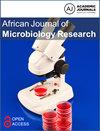Aflatoxins B1 contamination levels in maize and awareness of aflatoxins among main maize stakeholders in Chemba and Kondoa Districts, Tanzania
引用次数: 1
Abstract
Maize (Zea mays) is the staple food for the majority of people in Tanzania which plays a key role in subsistence and a cash crop among actors of the maize value chain. Environmental factors such as soil contamination by fungi, water stress, warm and humid conditions are among several factors contributing to fungal growth and aflatoxins contamination in maize, leading to significant economic loss, reduced household income, health problems to humans and animals and interferes with food security to communities. Structured questionnaires were used to collect information on awareness associated with aflatoxin contamination in maize from 160 smallholder farmers, 160 consumers and 60 traders in Kondoa and Chemba districts in Dodoma Region. A total of 90 maize samples (40 from smallholder farmers, 30 from consumers and 20 from traders) were analyzed for AFB1 using immunoaffinity high-performance liquid chromatography (HPLC) type Agilent Technologies 1200 serial. Data were statistically analyzed to assess awareness levels among maize main stakeholder and to check the current levels of aflatoxins B1 contamination in the study community. AFB1 was detected in five samples. About 3.3% of the contaminated maize had AFB1 levels above TBS acceptable levels (5 μg/kg). The highest mean concentration of AFB1 was in maize samples taken from traders with a mean of 9.88±5.904 μg/kg. The majority 56% of smallholder farmers and 52% of traders were aware of aflatoxins contamination and associated health effects on animals and humans. However, 74% of consumers were unaware of aflatoxins contamination in maize. The levels of contamination are low in the sample taken along maize value chain. An effective and broad awareness programme for community especially consumers on good management for prevention of aflatoxins contamination is necessary, as maize is the most consumed grain in the study area.坦桑尼亚Chemba和Kondoa地区玉米中黄曲霉毒素B1污染水平及主要玉米利益相关者对黄曲霉毒素的认识
玉米(Zea mays)是坦桑尼亚大多数人的主食,在玉米价值链各参与方的生计和经济作物中发挥着关键作用。真菌污染土壤、水分胁迫、温暖潮湿条件等环境因素是导致真菌生长和玉米黄曲霉毒素污染的几个因素之一,导致重大经济损失、家庭收入减少、人类和动物健康问题,并干扰社区的粮食安全。利用结构化问卷收集了Dodoma地区Kondoa和Chemba地区160名小农、160名消费者和60名贸易商对玉米中黄曲霉毒素污染的认识信息。使用Agilent Technologies 1200系列免疫亲和高效液相色谱(HPLC)对90份玉米样品(40份来自小农,30份来自消费者,20份来自贸易商)进行AFB1分析。对数据进行统计分析,以评估玉米主要利益相关者的认识水平,并检查研究社区中黄曲霉毒素B1污染的当前水平。5份样品中检测到AFB1。约3.3%的受污染玉米AFB1含量高于TBS可接受水平(5 μg/kg)。在贸易商采集的玉米样品中,AFB1平均浓度最高,为9.88±5.904 μg/kg。56%的小农和52%的贸易商意识到黄曲霉毒素污染及其对动物和人类健康的相关影响。然而,74%的消费者不知道玉米中含有黄曲霉毒素。沿玉米价值链取样的污染水平较低。由于玉米是研究地区消费最多的谷物,因此有必要为社区,特别是消费者制定有效和广泛的认识方案,使其了解预防黄曲霉毒素污染的良好管理。
本文章由计算机程序翻译,如有差异,请以英文原文为准。
求助全文
约1分钟内获得全文
求助全文

 求助内容:
求助内容: 应助结果提醒方式:
应助结果提醒方式:


